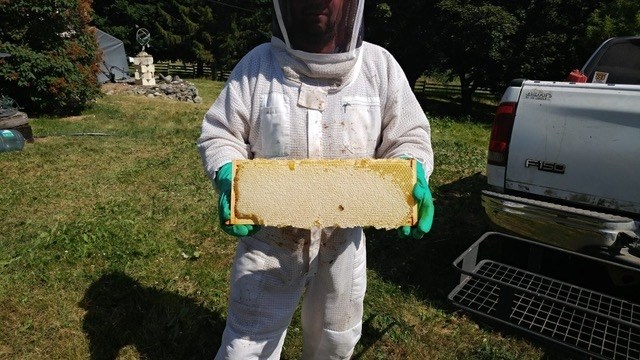
Lawrence Bergstrand is a beekeeper in Kamloops. He loves working with bees because it makes him feel closer to nature.
Image Credit: SUBMITTED/Deb McDougall
July 05, 2021 - 6:00 AM
There are currently over 2,000 beekeepers in British Columbia who are managing thousands of bee colonies.
The job comes with many challenges. The bees are threatened by mites, temperature extremes and windchill, and if they don't have enough space, the hive will simply fly away.
Lawrence Bergstrand and his wife, Deb McDougall, have been managing bees and making honey since 2009. They purchased their first two colonies from a beekeeper in West Kelowna. They now have two apiary yards in Kamloops called Sun Hill Apiaries.
"Looking after bees requires constant care," Bergstrand said. "The almost microscopic varroa mite can weaken the hive, so constant monitoring and treatments are necessary. The weather is also a factor. One year we had a short winter, then it really warmed up and then went to minus 20 degrees for months. I lost all of my hives except one. It took me years to recover."
Varroa mites are the most serious threat to honey bees. The parasites feed on the body fluids of adult and developing honey bees, weakening the bees and transmitting pathogens. Beekeepers must suppress the population of varroa throughout the beekeeping season. There is a large variety of products available on the market for treating varroa mites.
Bergstrand says colonies require weekly checks during the summer months to assess colony health and the strength of the colony and to add more "honey supers." These are special boxes that are removed to take honey away from the hive, or to make more space for the colony. If the bees don't have enough space, they will make a new queen and divide the colony.
"They slim down the old queen so she can fly and then she leaves with half the colony to find a new location," Bergstrand said. "Just like that, the beekeeper is down half a hive, about 25,000 bees, just because he wasn't assessing his hives enough. It's definitely a hard lesson to learn. These escaping bees and old queen don't travel very far and rest while a few searcher bees go out to seek a new place. They can all be caught by a beekeeper if they are called in time and if accessible."
In the winter, honey bees keep the inside of their cluster warm by exercising muscles and expending energy. Windchill is the biggest risk factor for bees in the winter. Beekeepers must put the beehive in a shelter, protected from the wind.
In extremely hot weather, like we are having now, bees will spread out and fan their wings. Beekeepers must ensure there is water available, either set out in dishes or supplied using feeders. Ventilation is a must. Extreme heat can make bees aggressive.
So far, the bees at Sun Hill Apiaries are coping well with the current extreme high temperatures. Bergeron will continue monitoring, keeping his hives healthy and collecting delicious honey.
"My bees are keeping the hive at around 90 degrees Fahrenheit, even in this temperature," he said. "They are really good at maintaining the correct hive temperature in order to raise the brood."
You can support bees in your area by planting bee friendly plants, providing bees with a fresh water source and being careful with insecticide applications. You can also support your local beekeeper by buying local honey.
We welcome your comments and opinions on our stories but play nice. We won't censor or delete comments unless they contain off-topic statements or links, unnecessary vulgarity, false facts, spam or obviously fake profiles. If you have any concerns about what you see in comments, email the editor.
News from © iNFOnews, 2021